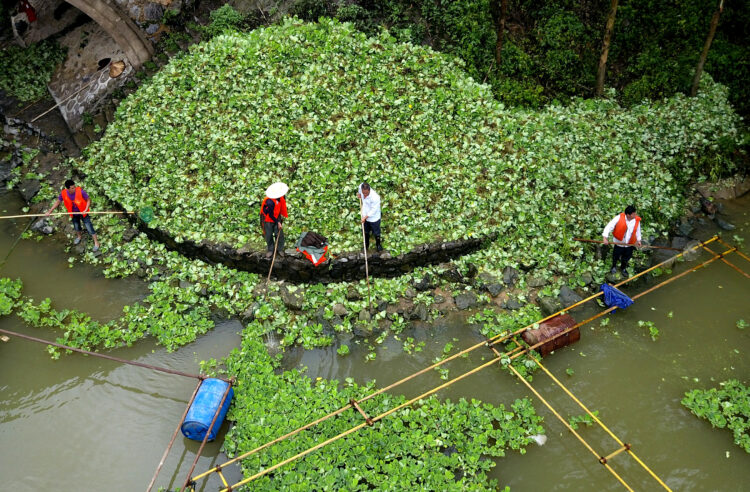New Delhi: In a groundbreaking findings, over 37,000 alien species, comprising India’s hyacinth and Lantana, have been introduced by many human activities to regions and biomes around the world, a major new report made public on Monday by the Intergovernmental Platform on Biodiversity and Ecosystem Services (IPBES) said.
This conservative assessment over more than four years is now rising at unprecedented rates. More than 3,500 of these are harmful invasive alien species — seriously threatening nature, nature’s contributions to people and good quality of life.
Too often ignored until it is too late, invasive alien species are a significant challenge to people in all regions and in every country.
The severe global threat posed by invasive alien species is underappreciated, underestimated, and often unacknowledged.
Approved on Saturday in Bonn, Germany, by representatives of the 143 member states of IPBES, the Assessment Report on Invasive Alien Species and their Control finds that alongside dramatic changes to biodiversity and ecosystems, the global economic cost of invasive alien species exceeded $423 billion annually in 2019, with costs having at least quadrupled every decade since 1970.
In 2019, the IPBES Global Assessment Report found that invasive alien species are one of the five most important direct drivers of biodiversity loss — alongside changes in land and sea-use, direct exploitation of species, climate change and pollution.
On the basis of this finding, governments tasked IPBES to provide the best available evidence and policy options to deal with the challenges of biological invasions.
The resulting report was produced by 86 experts from 49 countries. It draws on more than 13,000 references, including very significant contributions from Indigenous Peoples and local communities, making it the most comprehensive assessment ever carried out of invasive alien species around the world.
“Invasive alien species are a major threat to biodiversity and can cause irreversible damage to nature, including local and global species extinctions, and also threaten human wellbeing,” said Professor Helen Roy (United Kingdom), co-chair of the Assessment with Prof Anibal Pauchard (Chile) and Prof Peter Stoett (Canada).
The authors of the report emphasise that not all alien species become invasive — invasive alien species are the subset of alien species that are known to have become established and spread, which cause negative impacts on nature and often also on people.
About six per cent of alien plants; 22 per cent of alien invertebrates; 14 per cent of alien vertebrates; and 11 per cent of alien microbes are known to be invasive, posing major risks to nature and to people.
People with the greatest direct dependence on nature, such as Indigenous Peoples and local communities, are found to be at even greater risk. More than 2,300 invasive alien species are found on lands under the stewardship of Indigenous Peoples — threatening their quality of life and even cultural identities.
While many alien species were historically introduced on purpose for their perceived benefits to people, the IPBES report finds that the negative impacts of those that do become invasive are enormous for nature and people.
“Invasive alien species have been a major factor in 60 per cent and the only driver in 16 per cent of global animal and plant extinctions that we have recorded, and at least 218 invasive alien species have been responsible for more than 1,200 local extinctions. In fact, 85 per cent of the impacts of biological invasions on native species are negative,” said Prof Pauchard.
Examples of such impacts include the ways that North American beavers (Castor canadensis) and Pacific Oysters (Magallana gigas) change ecosystems by transforming habitats — often with severe consequences for native species.
Nearly 80 per cent of the documented impacts of invasive alien species on nature’s contributions to people are also negative, especially through damage to food supplies, such as the impact of the European shore crab (Carcinus maenas) on commercial shellfish beds in New England and the damage caused by the Caribbean false mussel (Mytilopsis sallei) to locally important fishery resources in India.
Similarly, 85 per cent of documented impacts negatively affect people’s quality of life — for instance through health impacts, including diseases such as malaria, Zika and West Nile Fever, spread by invasive alien mosquito species like Aedes albopictus and Aedes aegyptii.
Invasive alien species also damage livelihoods, for example in Lake Victoria where fisheries have declined due to the depletion of tilapia, as a result of the spread of water hyacinth (Pontederia crassipes), which is the world’s most widespread terrestrial invasive alien species.
Lantana (Lantana camara), a flowering shrub, and the black rat (Rattus rattus) are the second and third most widespread globally, with far-reaching impacts on people and nature.
The report shows that 34 per cent of the impacts of biological invasions were reported from the Americas, 31 per cent from Europe and Central Asia, 25 per cent from Asia and the Pacific and about seven per cent from Africa.
Most negative impacts are reported on land (about 75 per cent) — especially in forests, woodlands and cultivated areas — with considerably fewer reported in freshwater (14 per cent) and marine (10 per cent) habitats.
Invasive alien species are most damaging on islands, with numbers of alien plants now exceeding the number of native plants on more than 25 per cent of all islands.
(IANS)














